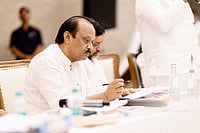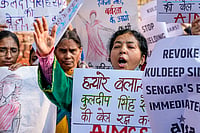
For this fiscal, then, the outcome budget lists programmes to be taken up by 61 ministries/departments and the money allocated for each quarter. For instance, the department of road transport and highways lists a total outlay of Rs 8,800 crore on civil construction works underNHAI, with the liability of Rs 5,970 crore (on public issue/bonds). The target: building 767 km of the Golden Quad and 981 km of the North-South and East-West corridors.
The 'remark/risk factor' is 5,846 sq km of GQ to be completed by December 2006. So, if you compare the cumulative GQ build-up at the end of the March '06 (5,464 kms), you know immediately whether it is a achievable target—at this pace, another 382 km seems feasible in the nine months from April '06. Of course, the next edition of the outcome budget—out next quarter—will have the figures of actual construction to make comparison easy.
Under the Sarva Shiksha Abhiyan programme of the department of elementary education and literacy (HRD ministry), there's an outlay of Rs 7,800 crore for this fiscal. The list of "quantifiable deliverables" is excellent and exhaustive. But the risk factors say enrolment of 8.13 million out-of-school children in regular schools and other centres is dependent upon proper updating of village education registers by state governments. Similarly, the prospects for providing drinking water facilities in these schools are clouded by time overruns in the release of the state's share of funds and their release in small, multiple instalments.
The Accelerated Irrigation Benefit Programme (AIBP), intended to complete ongoing irrigation and multipurpose projects, is incumbent on the ability of the states to raise required market borrowings and also put up their matching shares. The programme of repair, renovation and restoration of water bodies linked to agriculture is again dependent upon the project proposals being submitted by state governments.
The outcome budget makes it clear that the central government, specifically the finance ministry, is only a small part of the development story. And good monitoring and coordinating mechanisms (with the state) need to be firmed up to make the outcome budget useful. "Initially," says PC, "the focus of evaluation would be the flagship programmes and schemes like SSA, NREGP, ICDS and the mid-day meal, the components of Bharat Nirman, and the national highways." For some years now, the department of expenditure has been practising several tightening measures: quarterly ceilings and targets for expenditure, converging different schemes, targeting subsidies, and reviewing user charges. The outcome budget is but the final step to complete expenditure management, which will be possible only when the states take it up too, hopes PC.
It's just as well. Manmohan Singh told Parliament on Wednesday that if the economy grew at 7-8 per cent, there'd be no problem finding resources for development. He also said "those who are linked to governance in any way shouldn't hurt economic growth". Unfortunately, since the Prakash Karat brand of Leftists aren't linked to much governance, an outcome budget could be the only way to eventually turn off the tap on grand schemes.






















